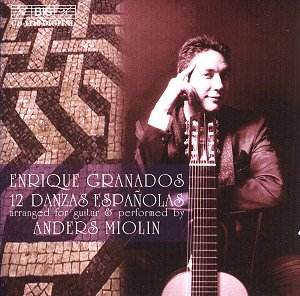The
ten-stringed guitar was not invented by the great twentieth century
player NarcisoYepes, but redesigned by him to extend the possibilities
of the conventional six-stringed instrument now known as the classical
guitar. Its greater resonance and wider compass a creates new
harmonic possibilities, though it also presents the player with
tricky technical problems. By the addition of four strings its
tuning resembles that of a lute more closely than a six-string
guitar, and the larger instrument has been particularly successful
in guitar transcriptions of baroque lute music, especially that
of J.S. Bach.
The
twelve Spanish Dances by Granados, originally written for piano,
are ‘guitaristic’ in character, and sound so effective on the
guitar that some of them have become part of its standard repertoire.
On this disc the delicate romanticism of these short characteristic
pieces is well realised but - perhaps in an effort more
fully to exploit the capabilities of the ten-stringed guitar -
Miolin has chosen a preponderance of open low positions and
slow tempi. These give many of the dances a somewhat ponderous
character that saps their vitality. Add to this widely-spreading
arpeggios take them even further from the essentially melodic
nature of the salon miniature. One misses the virile rhythms inherent
in such dances as Andaluza and Rondalla Aragonesa. All are by
definition dances, and I fear that their choreographic qualities
are sometimes missing in this performance.
I
did not unconditionally recommend a recently reissued 1990 recording
of the dances played on two guitars by Angel and Celedonio Romero
(Telarc CD-80216 ) for different reasons, but find their rather
cold interpretation preferable to this self-indulgent one..
Roy
Brewer
